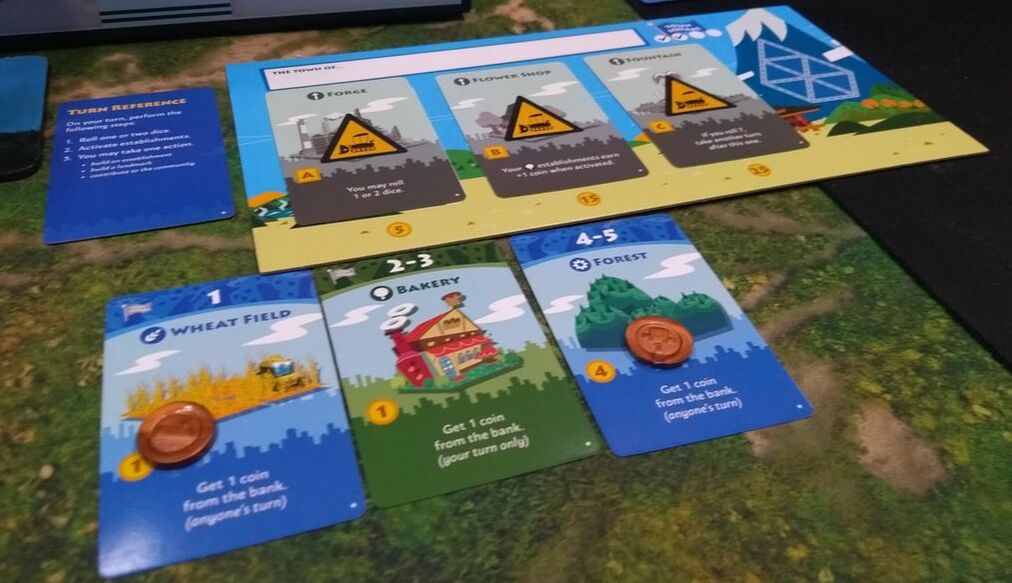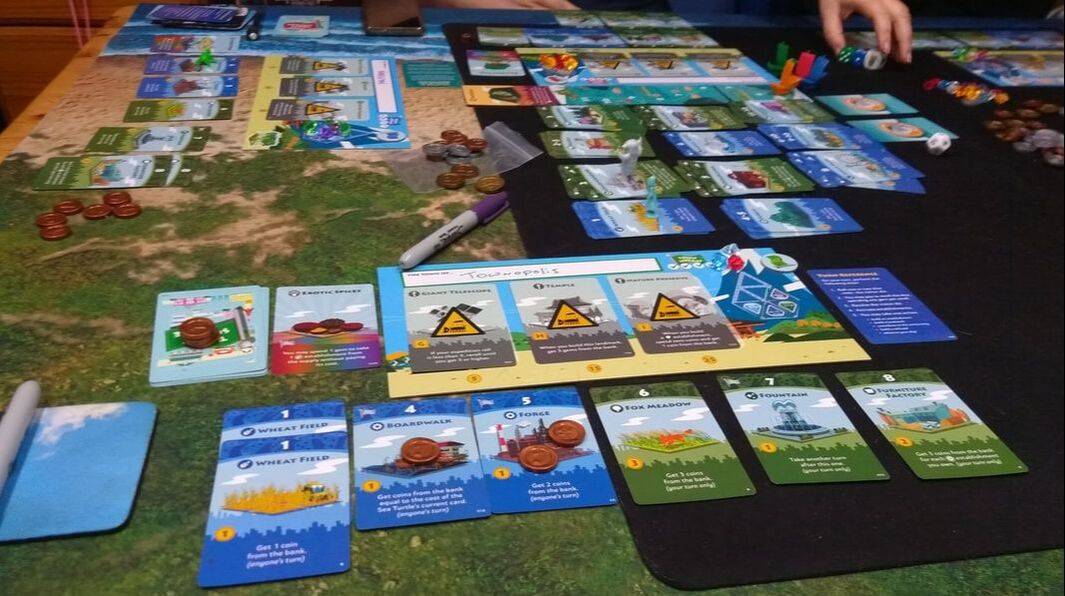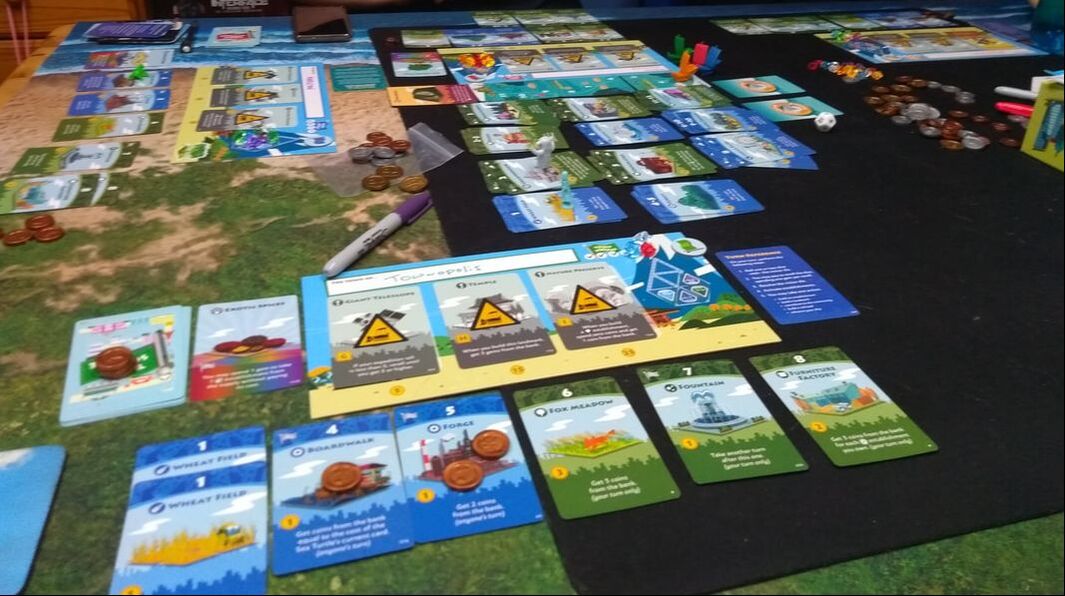|
21st September 2019. It's Saturday evening round at Matakishi's and that can only mean games night! So here we have 'Machi Koro Legacy'. As the title suggests, this is a legacy version of the very good Machi Koro game. Spoilers!!! Don't read any further ahead if you want to play Machi Koro Legacy! What's a legacy game? Glad you asked. A legacy game's unique feature is that it is actually a series of play-throughs of the same game. After each game concludes, something changes, is added or removed from the game and that change carries over to the next play-through of the game. Thus you have (In theory.) a game that constantly changes and evolves according to player input. Machi Koro Legacy is played over 10 games. We played games 1-5 in one night and in total all 10 games were played over 3 evenings. I'm going to blog about all of the games in this post. Since at the time of writing, these blog posts are about a month behind the actual plays. If you don't know anything about Machi Koro, you can read my blog about it here. Have you read it? Good! Now you know all about Machi Koro. The Basics The original Machi Koro has 2 expansions, 'The Harbour' and 'Millionaire's Row'. Generally we play Machi Koro with The Harbour. As you would expect, the core mechanics of Machi Koro remain unchanged for the 'legacy' version. If you didn't actually bother reading my blog about the main game: Here's a quick recap.
The legacy game I can't really blog about the game in my normal format because the components and rules change throughout the game. So I'll just go through it as best as I can. I'm not going to extensively talk about the original, I'll try to just talk about any differences between 'original' and 'legacy' versions. Personal game board This is immediately different. In legacy, each player is given a game board that has the following:
Diamonds are a new currency introduced in Legacy. Players can start a game with diamonds or acquire them during play. Some landmarks and cards can use diamonds for a benefit. But the main use of diamonds is to spend them to re-roll dice rolls. Double sided establishment cards These are an entirely new type of game introduced in Legacy. When a game is concluded, a new type of card is added to the market from the next game onward. These cards are 'double sided'. One side tends to be blue/green and the other red or occasionally purple. The player who just won the concluding game gets to choose which side is used, these cards have tick boxes which can ticked to indicate which side was initially chosen. During later games, it is possible that a stack of double sided cards can be flipped over to their other side. If this occurs, then it also affects all copies of that card in players' areas! (See below for how 'flipping' can occur.) Traveller die Another new introduction to legacy is the 'traveller die', a blank six sided die. What's the point of a blank die you may ask? Well, it doesn't stay blank for long. As games are completed, stickers are added to die. The traveller die is now rolled along with the normal dice. The following stickers are added to the traveller die: Turtle, yokai and moon princess There 3 travellers each have their own little figure that moves along cards as dictated by the rules for the traveller die.
The sea Another new addition to legacy that appears later in the game is 'the sea'. This is depicted by placing 3 cards in a column in the market area along side the establishment cards. Then, each player receives a boat figurine in their colour and a 12 sided die is introduced into the game. What does this all do? Well, read on:
Islands When the sea has been introduced, islands are next. Islands work in the following way.
During one of the latter games, the players will acquire rockets for their ships and in the 10th and final game, they will travel to the moon in an endeavour to return the moon princess home.
Right that's about it for what's in the game and rules. I've missed out some bits about some cards being removed from play and so on, but that I think is most of it. The 11th game Once the 10th game has concluded. The remaining cards can be used to make up a new game of Machi Koro. Having a functioning game afterwards is a nice touch. Overall I think this blog post I've written about Machi Koro Legacy is going to be the longest blog I've written about a card game so far. I guess a legacy game can complicate things quite a lot and there's quite a lot to process here. Additionally, I will state that this is the only legacy game I've ever played and I have nothing to compare it to or measure it against. I guess I'll just go through the things listed above and blog my thoughts about them. Town square cards I actually quite like this idea, it gives players a meaningful decision to make immediately and can lead to an asymmetrical game start (See below for more on this.). Landmarks As your small fishing settlement advances through civilisation to fulfil its destiny of becoming a 'space power', it's only natural that its landmarks will change over time. So thematically I understand it, but from a game play perspective, I'm ambivalent towards it. This is partially I think, because I didn't find them particularly interesting or useful. Especially since there's so many of them (10 communal and 12 player landmarks.) and they only hang around for a maximum of 3 games. Diamonds Diamonds have several uses in legacy. Some landmarks allow players to use diamonds for extra turns or for extra cash. They can also be used in conjunction with island cards to acquire establishment cards. But probably the biggest use of diamonds is for re-rolls. The original Machi Koro gave players a re-roll once per turn in the form of a landmark that they could purchase. Legacy take this a step further by giving players the ability to spend multiple diamonds to gain multiple re-rolls. This has a low impact in the early games, but a high impact in the later games. When a players has 8 diamonds, they spend a long time pondering their many potential re-rolls. I don't actually mind the game slowing down that much (I'm used to it.). I dislike how easy it is to just mitigate so many bad rolls. Having to deal with bad rolls is part of what makes Machi Koro what it is. Double sided establishments The idea of having dual-function establishments seems like a reasonable idea. It can change up the dynamic of the game a little and doesn't seem to have a negative impact. If only there was a better way to implement them other than the yokai (See Below.). Travellers Legacy adds 3 travellers to the game, as well as an extra die and extra rule to deal with it all. The problem I have with this is that all it does is introduce an extra random element and no game play element. When travellers do move, most of the time it has minimal or no impact on me or the decisions I made.
The sea When the sea was added into legacy, it introduced a fiddly and slightly confusing set of mechanics to the game. Not only that, they're completely alien to Machi Koro's 'style' and lack any elegance. You might as well have added a copy of 'Monopoly' to legacy, they're so different. Furthermore, when the sea was added to legacy was when the game started to really slow down. All those extra little rules and extras just dragged it down. It seems that the combination of the sea and diamonds is not a good one. Island cards The island cards are quite an interesting proposition.
The moon track is essentially an extension of the the sea track. Everything I've said about the sea, applies equally here. So that's it. As I explained earlier, this is the only legacy style game I've played. And to be honest, in regards to Machi Koro, I don't think it adds much to the experience of playing it.
Sure, it adds some interesting ideas to the mix and it was nice seeing new cards. But it also adds a whole lot of unnecessary stuff too. Additionally, the changes that occur throughout the games feel very small, the choice that the winner makes after every game feels inconsequential. I don't regret playing Machi Koro Legacy at all; it provided us with 10 games and 3 evenings of entertainment. But during those games I never felt that I was playing something superior to the original.
1 Comment
lisette
28/11/2020 04:24:01
can you hire me? bc your game really upsets me
Reply
Leave a Reply. |
AuthorI play, I paint. Archives
March 2024
Categories
All
|




 RSS Feed
RSS Feed
